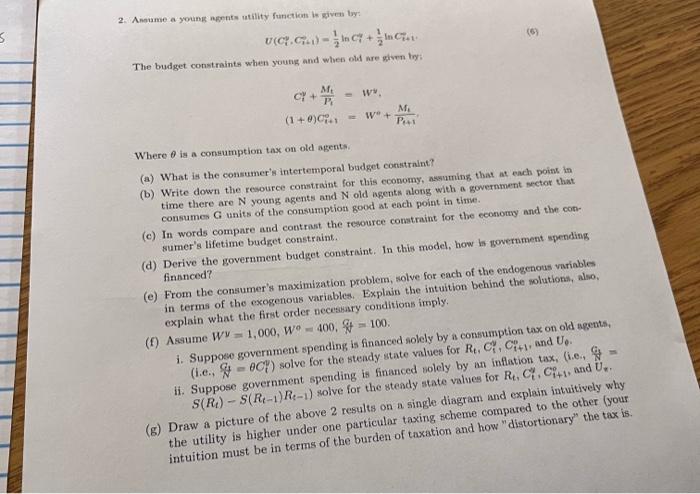Answered step by step
Verified Expert Solution
Question
1 Approved Answer
A-G 2. Ansume a young ngents wtility function is gives by: U(Ci,Ci,1)=21lnC7+21lnCt+1 The budget constraints when young and whes old sre given fry: Ciy+PtMt(1+)Ci+10=Wv=We+Pt+1Mi Where
A-G 
2. Ansume a young ngents wtility function is gives by: U(Ci,Ci,1)=21lnC7+21lnCt+1 The budget constraints when young and whes old sre given fry: Ciy+PtMt(1+)Ci+10=Wv=We+Pt+1Mi Where is a consumption tax on old agents. (a) What is the consumer's intertemporal budget contraint? (b) Write down the resource constraint for this economy, assumins that at each poins in time there are N young agents and N old agents along with a government sectot that consumes G inits of the consumption good at each point in thes. (c) In words compare and contrast the resource constraint for the econorty and the consumer's lifetime budget constrains. (d) Derive the government budget constraint. In this model, how h government spending firnnced? (e) From the consumer's maximization problem, solve for each of the endogenous variables in terms of the exogenous variables. Explain the intuition behind the nolutions, also. explain what the first order necesiary conditions imply, (f) Assume Wy=1,000,W=400, =100. i. Suppose government spending is financed solely by a consumption tax on old seents, (i.e., W1=Ct ) solve for the stendy state values for Rt,C5y,Ct+1n, and U0. ii. Suppose government spending is Enanced solely by an intation tax, (i.e., Gs 2= S(Rt)S(Rt1)Rt1) solve for the steady state values for Rt,Ct2,Ci+1, and Uz. (g) Draw a picture of the above 2 results on a single diagram and explain intuitively why the utility is higher under one particular taxing, rcheme compared to the other (your intuition must be in terms of the burden of taxation and how "distortionary" the tax is. 2. Ansume a young ngents wtility function is gives by: U(Ci,Ci,1)=21lnC7+21lnCt+1 The budget constraints when young and whes old sre given fry: Ciy+PtMt(1+)Ci+10=Wv=We+Pt+1Mi Where is a consumption tax on old agents. (a) What is the consumer's intertemporal budget contraint? (b) Write down the resource constraint for this economy, assumins that at each poins in time there are N young agents and N old agents along with a government sectot that consumes G inits of the consumption good at each point in thes. (c) In words compare and contrast the resource constraint for the econorty and the consumer's lifetime budget constrains. (d) Derive the government budget constraint. In this model, how h government spending firnnced? (e) From the consumer's maximization problem, solve for each of the endogenous variables in terms of the exogenous variables. Explain the intuition behind the nolutions, also. explain what the first order necesiary conditions imply, (f) Assume Wy=1,000,W=400, =100. i. Suppose government spending is financed solely by a consumption tax on old seents, (i.e., W1=Ct ) solve for the stendy state values for Rt,C5y,Ct+1n, and U0. ii. Suppose government spending is Enanced solely by an intation tax, (i.e., Gs 2= S(Rt)S(Rt1)Rt1) solve for the steady state values for Rt,Ct2,Ci+1, and Uz. (g) Draw a picture of the above 2 results on a single diagram and explain intuitively why the utility is higher under one particular taxing, rcheme compared to the other (your intuition must be in terms of the burden of taxation and how "distortionary" the tax is 
Step by Step Solution
There are 3 Steps involved in it
Step: 1

Get Instant Access to Expert-Tailored Solutions
See step-by-step solutions with expert insights and AI powered tools for academic success
Step: 2

Step: 3

Ace Your Homework with AI
Get the answers you need in no time with our AI-driven, step-by-step assistance
Get Started


